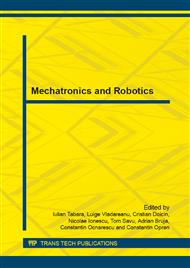p.3
p.11
p.21
p.27
p.33
p.41
p.47
p.55
Design and Simulation the Manipulator SI2M Used in Microfactories
Abstract:
In the precision engineering field, a large number of applications require precise and micro-level manipulation. In the last decade the demand of micro products and miniaturization has seen a wide spread growth. The microfactories concept was first developed in In the precision engineering field, a large number of applications require precise and micro-level manipulation. In the last decade the demand of micro products and miniaturization has seen a wide spread growth. The microfactories concept was first developed in the late twentieth century in Japan. With the development of the microfactories field has evolved the compliant mechanisms field. In this paper a microrobotic cell with an original manipulator for microassembly with a compliant gripper is designed, simulated and analyzed. The compliant gripper is mounted on a five bar mechanism with conventional joints in order to achieve a larger workspace. The vertical motion is produced by the linear actuator. The kinematics of the five bar mechanism and the workspace boundaries are analyzed based on the input parameters. For the compliant gripper is realized a 3D model and FEM analysis is conducted based on input displacement by the piezoelectric actuator. late twentieth century in Japan. With the development of the microfactories field has evolved the compliant mechanisms field. In this paper a microrobotic cell with an original manipulator for microassembly with a compliant gripper is designed, simulated and analyzed. The compliant gripper is mounted on a five bar mechanism with conventional joints in order to achieve a larger workspace. The vertical motion is produced by the linear actuator. The kinematics of the five bar mechanism and the workspace boundaries are analyzed based on the input parameters. For the compliant gripper is realized a 3D model and FEM analysis is conducted based on input displacement by the piezoelectric actuator.
Info:
Periodical:
Pages:
27-32
Citation:
Online since:
May 2015
Authors:
Keywords:
Price:
Сopyright:
© 2015 Trans Tech Publications Ltd. All Rights Reserved
Share:
Citation:


